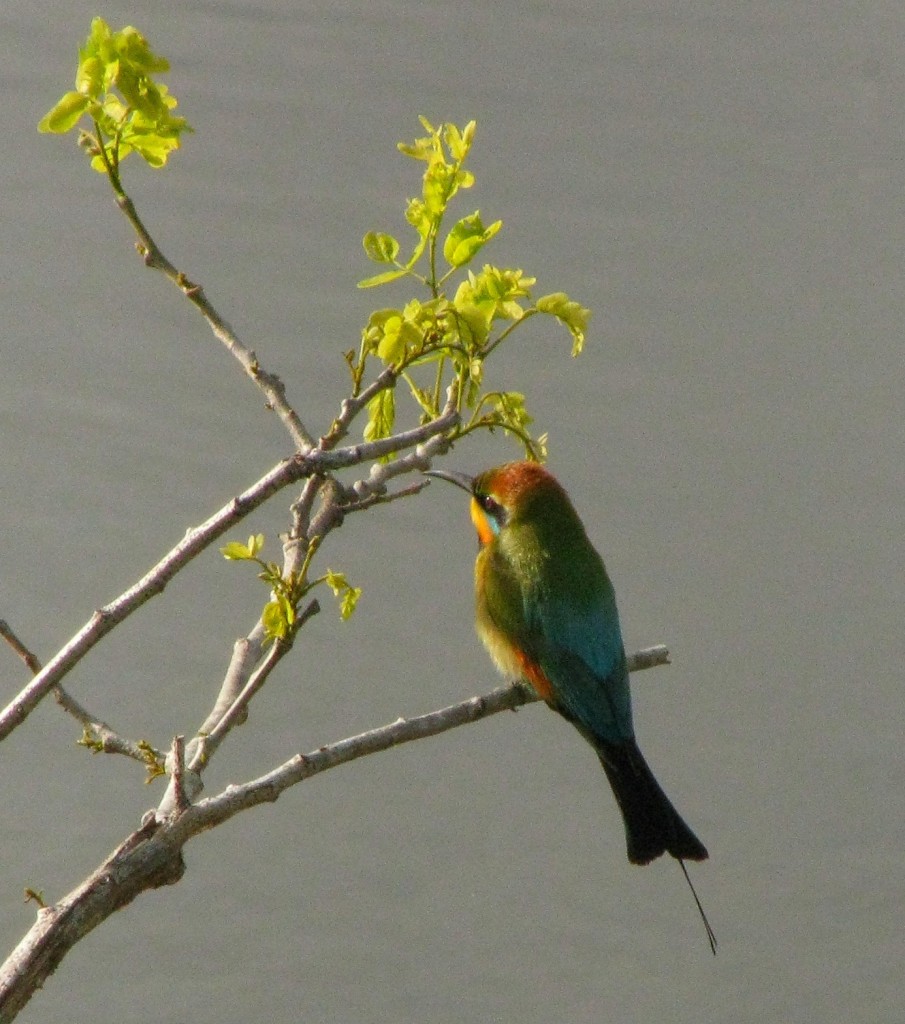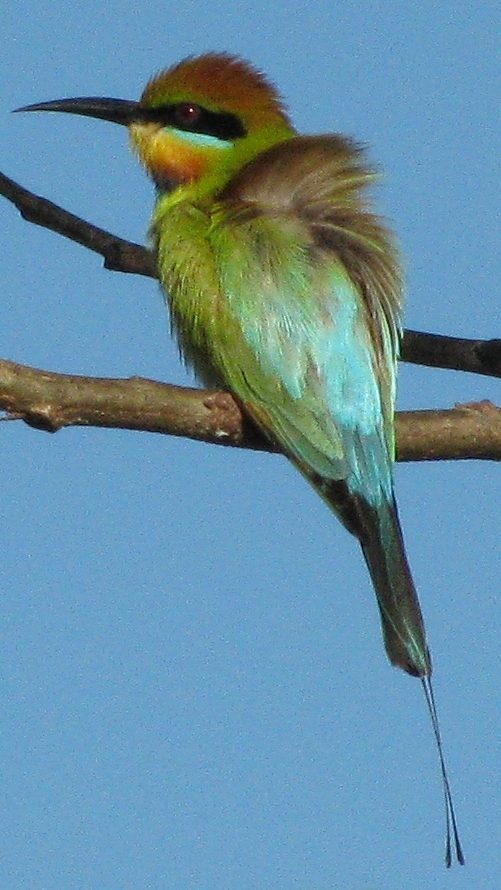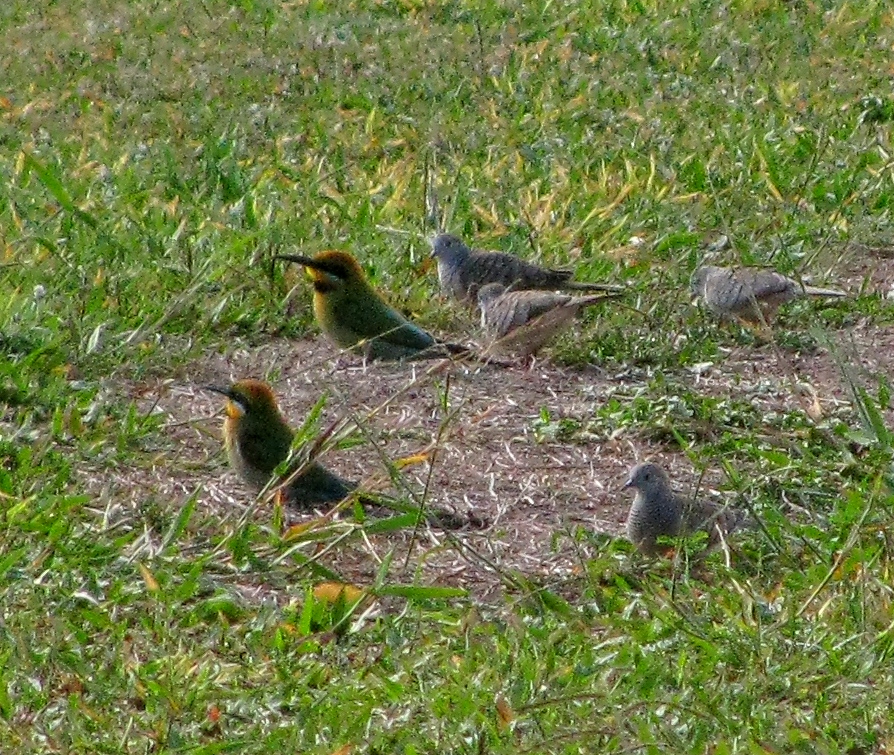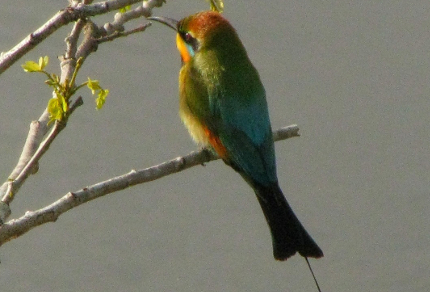
Male Rainbow Bee-eater (© Magi Nams)
This morning, I strolled Townsville’s Ross River Parkway in sun-warmed breezes, drinking in the sight of glossy, new leaves on fig and bottle trees, and the colourful profusion of parkway birds. Rainbow lorikeets in swift flight flashed vivid hues against the sky. A turquoise and buff sacred kingfisher perched amid fern-like poinciana leaves. Experimenting with flight, an immature little corella flapped white, sunlit wings, fluttering from perch to perch among dried leaf bases still attached to the trunk of a palm tree. Sleek welcome swallows swooped and darted, their bodies glistening, fork-tailed arrowheads of navy and rust. Rainbow bee-eaters which, if I was handing out Australian Avian Awards would receive the one designated for Most Beautiful Bird, trilled rolling, burring songs from powerlines and bare branches, their brilliant plumages tasteful collages of blue, green, black, and rust.

Male Rainbow Bee-eater (© Magi Nams)
Rainbow bee-eaters are the only Australian member of the avian family Meropidae, which is composed of 24 bee-eater species that occur from Europe and Africa east through Asia and southeast into Australasia, although none inhabit New Zealand.1 The Australian species can be found throughout much of the country, with the exception of a large, kidney-shaped region of arid lands shared by Western Australia, South Australia, and the Northern Territory.2
All bee-eaters are brightly-coloured and acrobatic insect-hunters which neutralize or remove the stingers of potentially poisonous prey, such as bees and wasps, before eating the insects or feeding them to offspring or a mate.1 Incredibly fast and agile, rainbow bee-eaters dash into the sky in pursuit of insects, performing arcing glides, swooping dives, and pursuit maneuvers that would rival or exceed those of any fighter pilot. I’ve observed bee-eaters zeroing in on targets, snatching them out of the air with their slender, curved beaks, and then gliding back on triangular wings to exposed perches on fences, powerlines, or branches. On the campus of James Cook University, I watched a bee-eater bash a large, captured butterfly against its perch branch to de-wing it before consuming it.
Male and female rainbow bee-eaters look much alike, although males possess noticeably longer central tail shafts than do females. Bee-eaters that are residents of northern Australia, where flying insects are available year-round, may breed twice yearly. Those living in the south of the country breed during the Australian spring and summer and migrate to the north, or to Papua New Guinea, Indonesia, or the Solomon Islands to overwinter.2
The courtship/bonding ritual of rainbow bee-eaters involves pecking and digging on sandy ground (potential nest tunnel site) by both males and females.3 Once the mating bond is established, the female bee-eater digs a metre-long tunnel in the soil by loosening grass and soil particles with her beak, and then kicking them backward while balancing on the ground on her chest and ‘elbows.’ She excavates only if her mate is nearby to stand sentinel and warn her of danger.3
After the tunnel and a 15-centimetre nest chamber are excavated, which requires two to three weeks of pecking and scratching, the female lays about five eggs in the nest chamber.3 The female and her mate both incubate the eggs, which hatch after 24 days, and both hunt food for the young.3 Nestling rainbow bee-eaters are fed by their parents for four to five weeks, and spend an additional four to five weeks with the adult pair, learning the intricacies of bee-eater flight and hunting strategy.3 In good nesting sites, rainbow bee-eaters may nest in loose colonies, with helper birds assisting the breeding adults.2
As I write this post, it occurs to me that I may have unknowingly seen such a colony in the Townsville suburb of Annandale, where one morning, bee-eaters were everywhere, perched in trees and on the gently sloping, mowed bank above the river. I’d never before seen so many bee-eaters on the ground, but not then realizing that bee-eaters nest in the ground rather than in trees, didn’t make the connection. I simply soaked up their beauty, their multi-hued plumages like rich scraps of satin tossed onto the grass.

Rainbow Bee-eaters and Peaceful Doves (© Magi Nams)
Today’s birds: magpie-larks, common koel, peaceful doves, brown honeyeaters, white-throated honeyeaters, masked lapwings, blue-faced honeyeaters, helmeted friarbirds, figbirds, rainbow lorikeets, yellow-throated miners, rock doves, Australian white ibises, mynas, yellow honeyeater, rainbow bee-eaters, house sparrow, little corellas, sacred kingfisher, white-gaped honeyeaters, crested pigeons, Toreesian crow, scaly-breasted lorikeets, brown goshawk, bush stone-curlew, great bowerbirds, black kite, straw-necked ibises, Australian magpies, welcome swallows.
.
References:
1. Graham Pizzey and Frank Knight. The Field Guide to the Birds of Australia. 1997. Angus & Robertson, Sydney, p. 536; 2. Ibid, p. 320.
3. Stella Mearns. The Private Lives of Rainbow Bee-eaters. The Bird Observer, August 2010, pp. 10-11 (published by Bird Observation & Conservation Australia).


